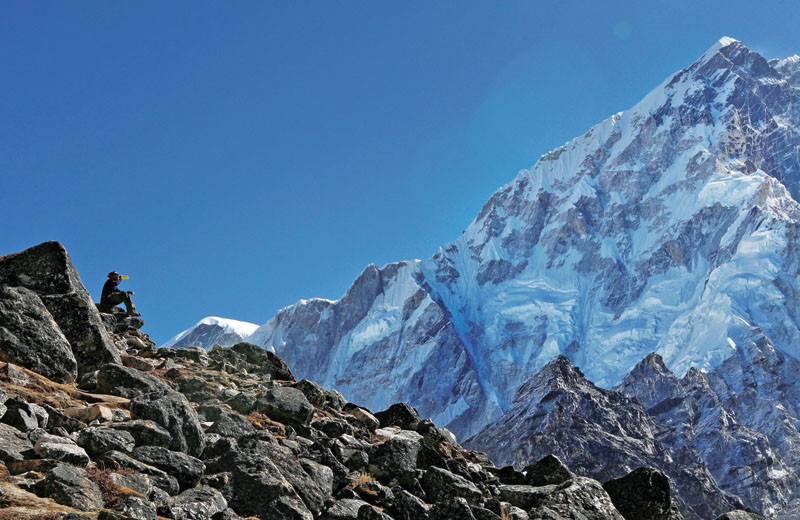Despite disasters, climbers return to Everest
Mt Everest Base Camp, April 23
When the earthquake struck last year and thousands of tonnes of snow and ice and earth came crashing down the mountain, some feared the climbers might never return to Mount Everest.
But despite back-to-back Everest disasters — the 2015 earthquake and a massive avalanche the year before — hundreds of mountaineers have come back for a new season. With them, they bring millions of dollars to this poverty-wracked nation.
Everest Base Camp has once again turned into a village of bright nylon tents and tea huts. It buzzes with commerce — trekkers on stopovers and mountaineers hoping to reach the 8,850-metre (29,035-foot) summit.
While the numbers of trekkers across Nepal is down about 40 per cent compared to last year, according to the Trekking Agencies Association of Nepal, the business community still sees that as good news.
“This is much more than what we all had expected,” said Pemba Sherpa, who runs a guest house in the village of Pheriche, about a day’s walk from Base Camp. “The climbers and trekkers who have reached here are very happy — satisfied at the condition of the mountain and not scared anymore.”
He’s just hoping this year passes quietly: “If there are any problems this year, then we are all finished. It will all end.”
Experience has shown, though, that there’s always the possibility of more trouble on Everest. More than 250 people have died on the mountain, which was first summitted by Tenzing Norgay and Edmund Hillary in 1953.
“Everest is the same, and the risks that were there are still there,” said Ang Tshering of the Nepal Mountaineering Association, an umbrella group. “It is not like a football field.”
The government has issued 289 Everest permits this year to foreign climbers, each of whom paid $11,000 for the chance to reach the summit. They will spend around two months on the mountain, acclimatising at lower altitudes before making their final attempts to reach the top.
“We have nearly as many climbers as in the previous years,” said Gyanendra Shrestha, an official at the Mountaineering Department.
It’s been years since the Everest region was truly isolated. Thousands of Sherpas and other Nepalis work as guides and porters, or do everything from renting out mules to serving hot coffee and home-cooked food in trail side cafés and lodges.
“We have no other income except from the tourists,” said Bal Krishna Rai, a 15-year-old porter carrying a load in a bamboo basket to Base Camp.
Many Sherpas hope to work as high-altitude guides, a dangerous but lucrative job that can earn someone up to $7,000 over a few months. Support workers can earn half that amount — still a lot in a country where the average per capita income is $700.
Money alone is enough to persuade many Sherpa guides to risk their lives year after year.
“I lost many of my friends in the last two years. I am scared, but I don’t have another option,” said Lakpa Nuru, 25, who was at Everest Base Camp during both recent disasters. Still, he is working again this year, attempting a sixth Everest ascent. “Most of us are here so that we can earn for us or our family. If the foreigners don’t come any more, we will all starve.”
The April 2014 avalanche, which killed 13 Sherpa guides and three other Nepali workers, was an
immense blow to the Sherpa community.
Nearly all surviving Sherpas refused to continue working that year, demanding, among other things, better working conditions, more insurance and free education for the children of those killed. The government met most of their major demands, including requiring expeditions to insure Sherpas for up to $15,000. But the season was effectively cancelled.
Last year, Sherpas had already set up two camps above Base Camp when the earthquake unleashed an avalanche that tore into the tent city, burying climbers and staff. Nineteen people were killed, 61 were injured and the pre-prepared route of ropes and ladders was destroyed. When the Sherpas refused to rebuild the route, the season was scrubbed. There were no successful climbs in 2015.
During the past two years, the government has enacted a series of policy changes, from stationing officials at Base Camp to creating a welfare fund for the families of the dead Sherpas. The moves were made largely to convince climbers and trekkers to keep coming back to Everest.
But, it turns out, it’s hard to keep the climbers away — including those with very little experience.
“I see an increased chance of large-scale accidents on the mountain based on the lower level of experience of everyone involved — not just the clients, but the Sherpas and the guides,” said Adrian Ballinger, a guide with California-based Alpenglow Expeditions. Ballinger, who has scaled Everest six times, spoke as he was preparing to make his seventh attempt on the summit.
Competition has dramatically driven down the cost of a guided climb, he said, with clients who used to pay $65,000 now paying as little as $22,000.
Ballinger believes Everest climbers should be required to have mountaineering experience, and guides — both local and foreign — should have climbing certification: “Adding more people with lower standards of experience, equipment, care and management is making the mountain more dangerous.”






